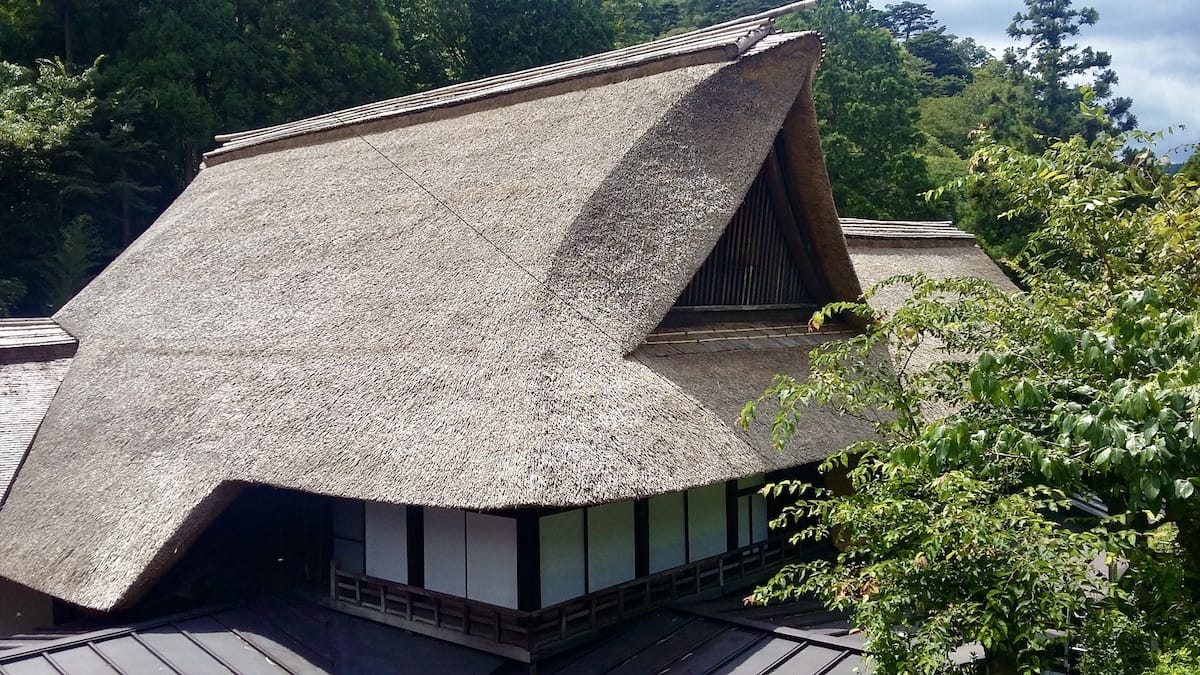
A house with a thatched roof on the way up Mt. Takao, Tokyo. | Photo by George Lloyd
Thatch: humble yet elegant roofing material in search of a new lease of life
- Tags:
- Japanese architecture / roofing / thatch / thatched roof

A house with a thatched roof on the way up Mt. Takao, Tokyo. | Photo by George Lloyd
In England and Denmark, there are still entire villages of thatched houses. While it is expensive to thatch a roof in those countries, it is not prohibitively so, and the tradition of thatching is very much alive.
In Japan, however, the era of the thatched roof is coming to an end. You can still see examples of thatching on the roofs of a few surviving temples, teahouses, farmhouses and cultural landmarks protected by the government. But the number of fulltime professional thatchers still working in Japan can probably be counted on the fingers of two hands.
This is especially sad because thatch used to be the standard roofing material in Japan. It was used not only on farmhouses, but on the country's grandest buildings. For example, the most important Shinto shrine in Japan, the Grand Shrine of Ise 伊勢神宮 in Mie prefecture, has a thatched roof.
Kōtai-jingū (Naiku) 皇大神宮(内宮)at Ise Grand Shrine 伊勢神宮. | N yotarou, CC BY-SA 4.0, via Wikimedia Commons
Several varieties of thatch are used on Japanese roofs. Most roofing thatch is made of susuki (芒) a high-growing grass with long, blade-like leaves and delicate seed fronds. Also known as Japanese pampas grass, it appears in countless screens and scrolls as the 'autumn grass’ so beloved of Japanese poets and painters.
When cut and bound to the roof of a farmhouse, Japanese pampas grass is called kaya(茅). Roofs thatched with kaya are more durable than those thatched with rice straw and can last for up to 70 years.
Another kind of grass used in thatching is shino (篠 dwarf bamboo), which is denser than kaya and is generally only used for the corners of the roof. It is cut in early spring, when the leaves fall off the dry stalks of bamboo.
A thatched house in Hamarikyū 浜離宮恩賜庭園, an Edo-era garden near Shinagawa, Tokyo. | Photo by George Lloyd
Not all roofs are made from kaya. A roof thatched with rice straw is a warabuki 藁葺き. A roof thatched with rushes is a tomabuki 苫葺き. A roof thatched with cypress bark shingles is a hiwadabuki 檜皮葺き.
There are plenty of other variations on traditional Japanese thatching techniques, depending on region, budget and family tradition. For example, some thatchers like to create a slight upward curve at the eaves by inserting a layer of rice straw under the edges of the roof.
An example of thatching on a Jōmon-era dwelling recreated in the grounds of Hachiman-gū shrine 八幡宮, Yoyogi, Tokyo. | Photo by George Lloyd
The history of thatch in Japan goes all the way back to the Jōmon era (c. 14,000–300 BCE). Traditionally, every country village had a thatch field and thatch was harvested as a regular part of the farming calendar. It was stored in communal sheds, and everyone pitched in to help when a thatched roof needed to be replaced. Materials were plentiful, as was work for thatchers, so it was not expensive to thatch a roof.
But since WW2, rural homeowners have opted to use modern roofing materials, like tiles, concrete or plastic. The more popular these materials became, the cheaper they became. Conversely, as thatch fell out of favour, it became more and more expensive.
These days, thatching a roof costs so much - and thatchers are so rare - that homeowners with thatched roofs often choose to simply cover them with corrugated iron or even plastic sheets rather than pay to have them rethatched.
A traditional outdoor kitchen with a thatched roof at the Edo-Tokyo Open Air Architectural Museum 江戸東京たてもの園. | Photo by George Lloyd
The Japanese countryside is changing. Every year, more young people from country towns and villages leave for the cities in search of work, and the average age of a farmer rises. In the future, the number of farmers is set to fall even further, and even more farmland will be abandoned.
Not all hope is lost, however. Every year, a steady trickle of incomers from the cities opt to turn their backs on city life and move to the countryside. The coronavirus pandemic has given fresh impetus to the phenomenon of the 'U-turn', though to what extent it will revitalise rural communities it's not yet possible to say.
Some of these urbanites, less in thrall to 20th century materials like concrete, steel and glass, and more appreciative of the beauty of traditional materials like timer, thatch and clay, are choosing to keep traditional crafts like thatching alive.
Thatch used to be considered the embodiment of elegance. Indeed, using humble materials to create sophisticated works of art is one of the defining characteristics of the Japanese artistic tradition. Perhaps the new generation will grasp this fundamental truth and put it into action.